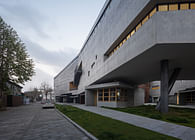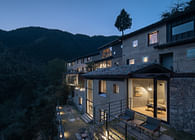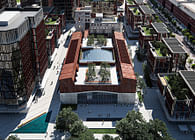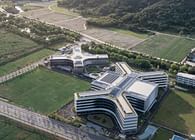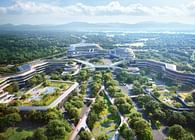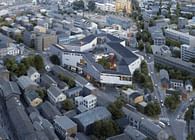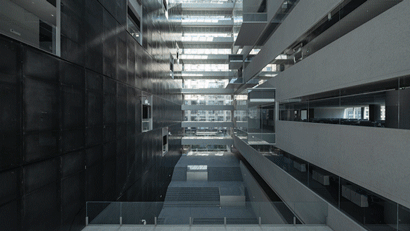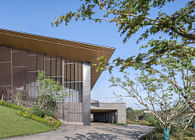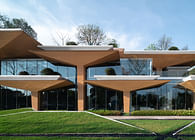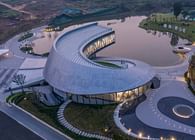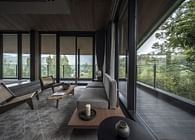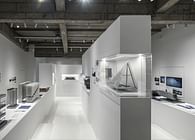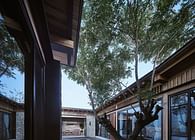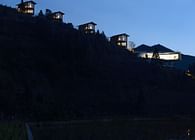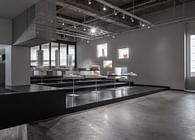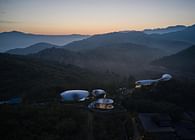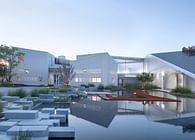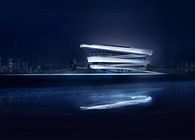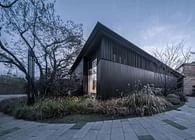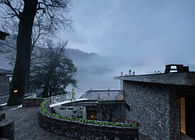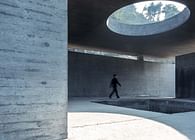
In the post-real estate era, the regional comprehensive development mode guided by the health industry in a broad sense is becoming a blue ocean to be excavated. In the context of format iteration, the definition of architectural type with a single function has gradually failed. We try to find a kind of flexible space to accommodate the needs of different scenes, blur the clear boundary between medical facilities and hotels, and accommodate the diverse scenes of health and vacation. We will create a landscape-courtyard in a tropical climate to build a new model of future medical and healthcare that responds to the transformation needs of the times.
——Fanhao Meng
A state-level medical and fitness recuperation base between mountains and seas
Sanya Haitang Bay, where the project is located, is positioned as a " A state-level medical and fitness recuperation base" based on its unique tourism and environment advantages. The exploration of the type boundaries of the elements of "Healthcare, Recuperation, Tourism, Residence and Recreation" is carried out together with the natural landscape pattern of Haitang Bay.
Prior to our intervention, the planning bureau and the developer had already engaged in several rounds of "demand tug-of-war": From the perspective of comprehensive urban development, the planning bureau wanted more than just row-like residential products; from the perspective of economic efficiency developers did not want a centralized layout with a single medical facility, straddling the balance between long-term upper level planning and immediate economic benefits, the demonstration center solved the problem by positioning itself as a "medical-hotel-based composite scene destination" and sketching a "landscape courtyard under tropical climate conditions" on the site.
Planning Layout: Intensive and Efficient Natural Courtyard
Medical treatment focuses on high efficiency, while recuperative vacation wants freedom. The project needs to solve the contradiction of "high efficiency and freedom" of large building volume within the density limit of 35% and the height limit of 40 meters of the site. The project maximizes the use of building density, reduces the number of floors, breaks up the whole into pieces and strengthens the enclosure, and forms a group courtyard layout in the demonstration center, which allows for the enclosure of leisure-scale landscape openings, while clearly defining the public and private zoning, coordinating with the sprawling mountain and sea landscape and integrating with the local residences in the urban scale.
After the zoning is clear, each flow line is established in a separate path. Between the courtyards, the corridor inside the building connects the semi-outdoor space and the courtyard verandah to form a convenient pedestrian path. The greenery inside the courtyard view borrowing the coconut grove outside the courtyard, and the pedestrian path is transformed into a relaxing strolling system.
Scene Composite: Composite Scene Destination For All Hours, Composite Functions For Flexible Changes
The "demand tug of war" makes the area of function uncertain, and the type of spatial operation are dynamically adjusted at any time. After refining the hospital function, the time-sharing, public, standardized medical function space is independently partitioned, and the full-time, private, personalized inpatient ward and medical life service space are overlaid with the resort scene to create a composite scene destination for all hours.
The overall 8.4×8.4m modular design of the demonstration center allows for the interchangeability of basic medical treatment and recuperative vacation spaces to meet expansion and renovation needs. the landscape balcony are placed in the multiple places on the the linear corridors in the recuperative vacation ward building to reduce the sense of closure of long corridors and create the soothing atmosphere of a resort-style hotel. All-age activity halls and other public spaces for recreation and wellness are also provided to realize a resort-style community experience.
Facade Style: Translating Traditional Architectural Language, Responding to the Regional Climate of The Island
Under the historical context and spatial order, the façade needs shaped in line with the hot and rainy tropical monsoon climate, and the control regulations to protect the traditional urban cultural appearance.
Translation of Traditional Roof
The independent and scattered courtyards are connected by continuous roofs, forming a unified body with a clear layout in the ambiguous spatial texture of the surrounding organization. At the same time, the symmetry of the traditional double-slope roof is broken, and the roof is folded into a mountain according to the primary and secondary functional relationship and height of the building, and the roof is continuous and gradually undulating, like the "big mountain" in the mountain and sea environment.
Shaping Gray Space and Layers
The façade is translated from the three-stage composition of Chinese architecture. The far-reaching eaves and the formal language of the paragraphs form a layered, rhythmic and orderly gray space. In the hot and rainy climate, the activity space is comfortable and pleasant, realizing a tropical resort atmosphere.
Derivation of Facade Motif
For different building functions and scales, a variety of façade types are derived, so that the demonstration center forms a cluster of buildings with the characteristics of settlements.
Material Selection And Construction: Epidermal Suturing Within Cost Limits
The eaves of nearly 5 meters and the middle wall of facade would have encountered many restrictions if traditional wood was used, so we translated it into the façade composition by examining the scale proportion and lap way of the wood structure through the model. At the same time, we chose modern materials to reduce the cost: steel diagonal braces and purlins, decorative masonry gable pad square, curtain wall aluminum square grille windows, etc. covered with imitation wood-like coating. The difference of wood color and grain density of different component have retained, thus building a more three-dimensional gray space color level.
In addition to the concrete main frame, the modelling of base window openings are framed with a lower-cost lightweight steel keel, covered with GRC cement fiber-board as the panels and painted with a light-colored concrete-like coating consistent with the walls, presenting a sharper contrast under the bright sunshine of Sanya.
we replaced traditional terracotta tiles with modern precast concrete tiles, and covered the roof with three shades of red tiles in an area ratio of 6:3:1, so that the roof presented richer color levels and more vivid texture from a distance.
With the superposition of efficient and free scenes, the demonstration center realizes the dynamic replacement of functions, as well as the mood and scenery that can be traveled in the courtyard. We explore the type boundary within the restriction of contradiction, and the formal language under the regulation of façade style control, extending the connotation of the elements of contemporary healthy human living style.
Status: Built
Location: Hainan, CN
Firm Role: Architect







